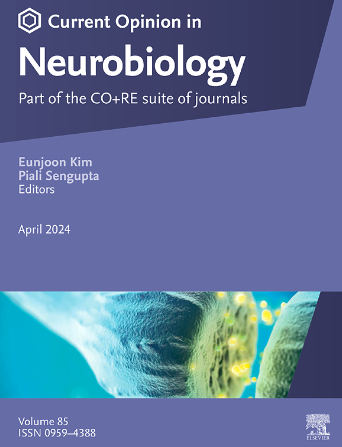Neurodevelopmental impact of CNV models in ASD: Recent advances and future directions
IF 5.2
2区 医学
Q1 NEUROSCIENCES
引用次数: 0
Abstract
Autism spectrum disorder (ASD) is a neurodevelopmental disorder characterized by social communication impairments and restricted, repetitive behaviors. ASD exhibits a strong genetic basis, with rare and common genetic variants contributing to its etiology. Copy number variations (CNVs), deletions or duplications of chromosomal segments, have emerged as key contributors to ASD risk. Rare CNVs often demonstrate large effect sizes and can directly cause ASD, while common variants collectively exert subtle influences. Recent advances have identified numerous ASD-associated CNVs, including recurrent loci such as 1q21.1, 2p16.3, 7q11.23, 15q11.2, 15q11-q13, 16p11.2 and 22q11.2. Mouse models carrying these CNVs have provided profound insights into the underlying neurobiological mechanisms. Recent studies integrating transcriptomic, proteomic, and functional imaging approaches have revealed alterations in synaptic function, neuronal differentiation, myelination, metabolic pathways, and circuit connectivity. Notably, investigations leveraging conditional knockout models, high magnetic field MRI, and single-cell analyses highlight disruptions in excitatory-inhibitory balance, white matter integrity, and dynamic gene regulatory networks. Parallel human-based approaches, including iPSC-derived neurons, cerebral organoids, and large-scale single-nucleus sequencing, are combined with animal model data. These integrative strategies promise to refine our understanding of ASD's genetic architecture, bridging the gap between fundamental discoveries in model organisms and clinically relevant biomarkers, subtypes, and therapeutic targets in humans. This review summarizes key findings from recent CNV mouse model studies and highlights emerging technologies applied to human ASD samples. Finally, we outline prospects for translating findings from mouse studies to humans. By illuminating both unique and convergent genetic mechanisms, these advances offer a critical framework for unraveling etiological complexity in ASD.
CNV模型对ASD神经发育的影响:最新进展和未来方向
自闭症谱系障碍(ASD)是一种神经发育障碍,其特征是社会沟通障碍和限制性重复行为。ASD表现出强大的遗传基础,罕见和常见的遗传变异有助于其病因。拷贝数变异(CNVs),染色体片段的缺失或重复,已经成为ASD风险的关键因素。罕见的CNVs通常表现出很大的效应大小,可以直接导致ASD,而常见的变异共同发挥微妙的影响。最近的进展已经确定了许多与asd相关的CNVs,包括复发位点,如1q21.1、2p16.3、7q11.23、15q11.2、15q11-q13、16p11.2和22q11.2。携带这些CNVs的小鼠模型为潜在的神经生物学机制提供了深刻的见解。最近的研究整合了转录组学、蛋白质组学和功能成像方法,揭示了突触功能、神经元分化、髓鞘形成、代谢途径和电路连接的改变。值得注意的是,利用条件敲除模型、高磁场MRI和单细胞分析的研究强调了兴奋性抑制平衡、白质完整性和动态基因调控网络的破坏。并行的基于人类的方法,包括ipsc衍生的神经元,脑类器官和大规模单核测序,与动物模型数据相结合。这些综合策略有望完善我们对ASD遗传结构的理解,弥合模式生物的基础发现与临床相关的生物标志物、亚型和人类治疗靶点之间的差距。本文综述了最近CNV小鼠模型研究的主要发现,并重点介绍了应用于人类ASD样本的新兴技术。最后,我们概述了将小鼠研究结果转化为人类研究的前景。通过阐明独特和趋同的遗传机制,这些进展为揭示ASD病因复杂性提供了一个关键框架。
本文章由计算机程序翻译,如有差异,请以英文原文为准。
求助全文
约1分钟内获得全文
求助全文
来源期刊

Current Opinion in Neurobiology
医学-神经科学
CiteScore
11.10
自引率
1.80%
发文量
130
审稿时长
4-8 weeks
期刊介绍:
Current Opinion in Neurobiology publishes short annotated reviews by leading experts on recent developments in the field of neurobiology. These experts write short reviews describing recent discoveries in this field (in the past 2-5 years), as well as highlighting select individual papers of particular significance.
The journal is thus an important resource allowing researchers and educators to quickly gain an overview and rich understanding of complex and current issues in the field of Neurobiology. The journal takes a unique and valuable approach in focusing each special issue around a topic of scientific and/or societal interest, and then bringing together leading international experts studying that topic, embracing diverse methodologies and perspectives.
Journal Content: The journal consists of 6 issues per year, covering 8 recurring topics every other year in the following categories:
-Neurobiology of Disease-
Neurobiology of Behavior-
Cellular Neuroscience-
Systems Neuroscience-
Developmental Neuroscience-
Neurobiology of Learning and Plasticity-
Molecular Neuroscience-
Computational Neuroscience
 求助内容:
求助内容: 应助结果提醒方式:
应助结果提醒方式:


